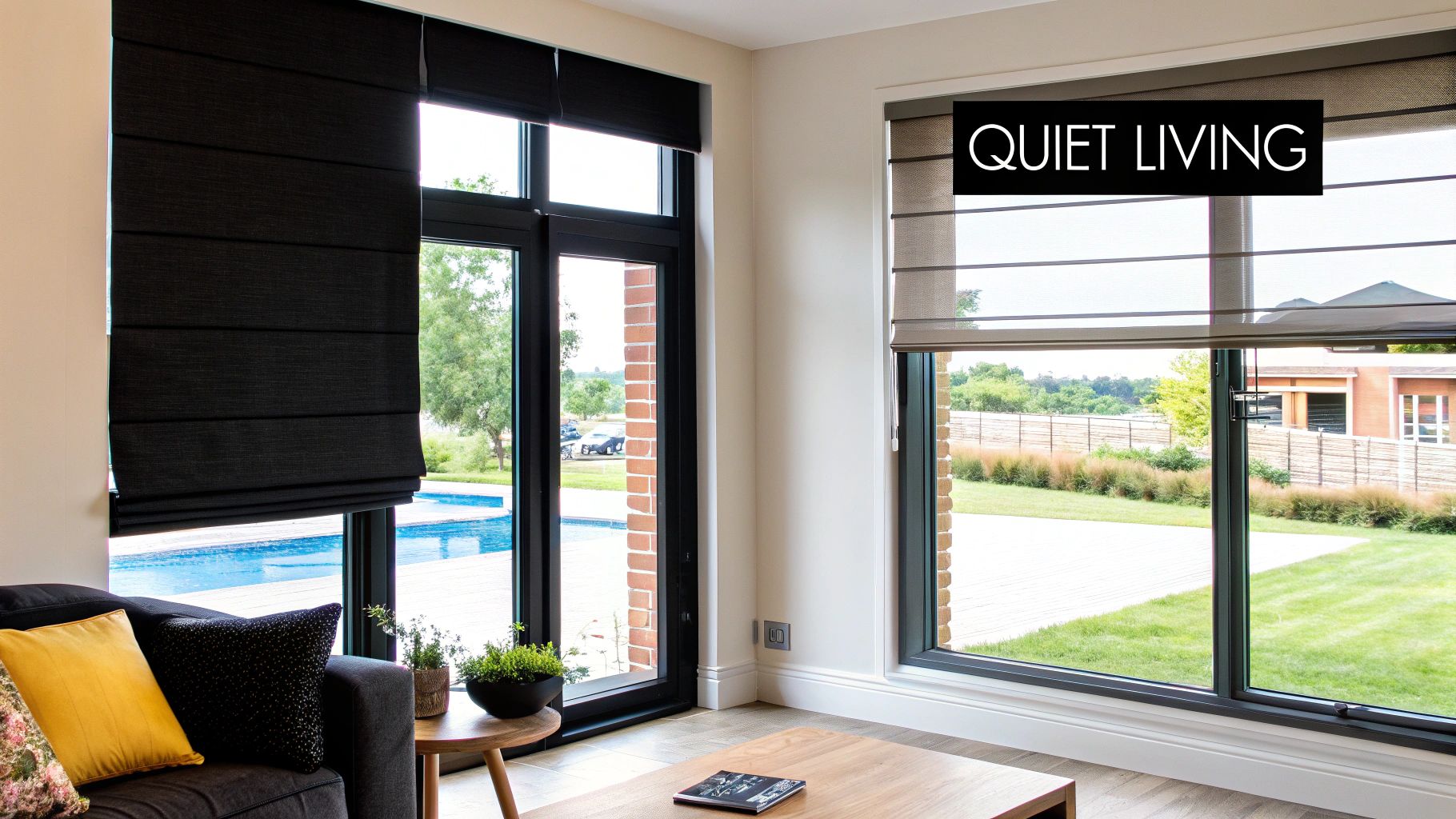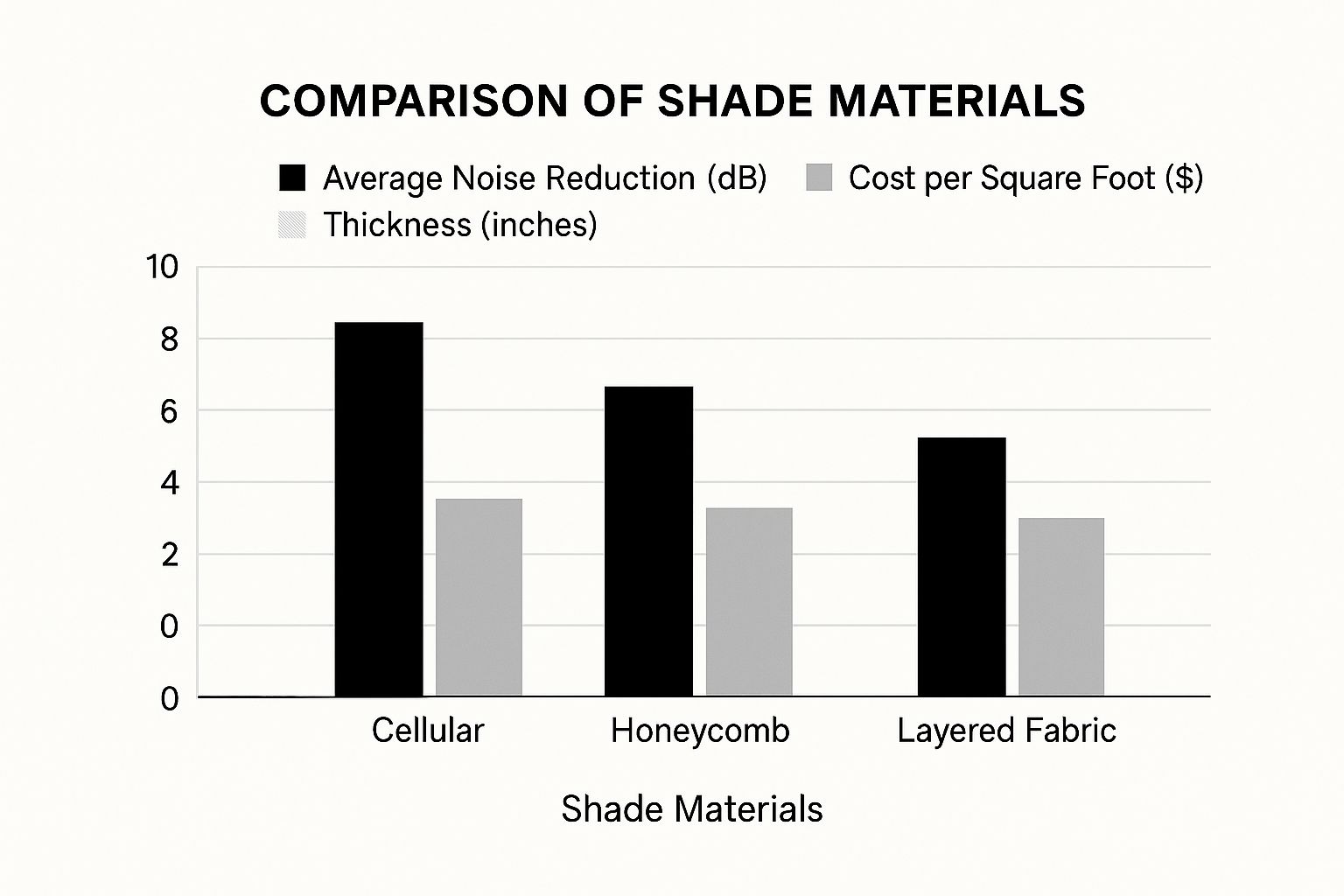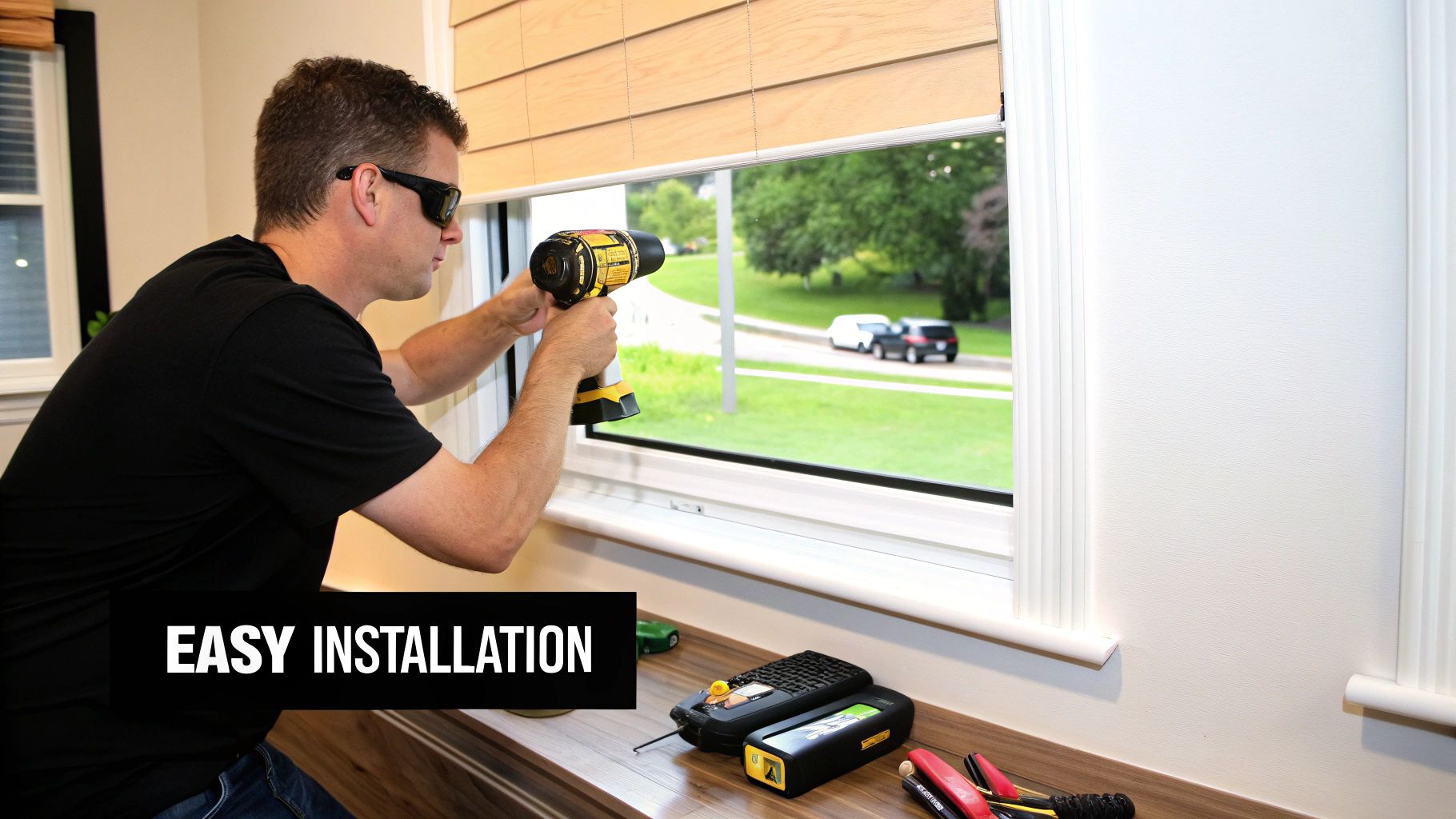Noise Reducing Shades: Your Complete Guide to Quieter Living
- Johann Reardon

- Jul 18
- 14 min read
Understanding What Makes Noise Reducing Shades Actually Work

Imagine trying to chat in a bustling restaurant. It's tough to hear over the din, isn't it? Noise reducing shades tackle a similar problem, but instead of battling conversations, they minimize unwanted outdoor sounds. They create a barrier, absorbing and deflecting sound waves before they disrupt your tranquility.
This desire for peace and quiet has driven a real need for noise control solutions. The global market for soundproof curtains, a close cousin of noise reducing shades, was valued at about $2.2 billion in 2024. It's expected to hit $2.37 billion in 2025, showing a 7.5% compound annual growth rate (CAGR). Discover more insights on the soundproof curtain market.
Beyond Basic Barriers: How Noise Reducing Shades Differ from Traditional Treatments
Regular blinds and curtains offer some light control and privacy, but they aren't built for serious noise reduction. Think of them as a flimsy piece of paper trying to block a strong breeze. They might flap a little, but the air still gets through.
Noise reducing shades, however, are made with special materials and techniques that make them much better at absorbing and blocking sound. Home Blinds & Floors offers a wide array of these specialized shades, ensuring a good fit for every home and budget.
The Secret Ingredients: Thickness, Density, and Construction Techniques
Effective noise reduction depends heavily on how the shades are made. Thickness is important, acting as the first defense against sound waves. But thickness isn't the whole story.
The density of the material matters even more. Denser materials absorb sound better, stopping it in its tracks. Picture this: a thick wool blanket will muffle sound more effectively than a thin cotton sheet, even if you stack several sheets together. Home Blinds & Floors helps customers navigate these details during their free in-home consultations.
More Than Meets the Eye: Specialized Features for Enhanced Performance
Finally, construction techniques also boost noise-blocking power. Some noise reducing shades use multiple layers of fabric with varying densities, working together to absorb a wider spectrum of sound frequencies.
Others use honeycomb or cellular structures. These structures trap air, creating extra sound barriers within the shade itself. These special features, often subtle, are what truly set noise reducing shades apart from standard window coverings. Home Blinds & Floors, as a trusted local provider, focuses on these key factors to ensure their solutions genuinely reduce noise and offer long-term value.
The Physics Behind Peace: How Sound Actually Gets Stopped
Ever notice how some rooms just seem to amplify noise? It's like they're echoing chambers for every passing car or neighborhood dog. That's because standard window treatments often do little to stop sound waves. Noise reducing shades, however, are designed specifically to combat this, acting as a sound barrier between your home and the outside world.
Mass: The First Line of Defense
Imagine trying to stop a rolling bowling ball with a sheet of paper versus a thick stack of books. The books, with their greater mass, offer significantly more resistance. The same principle applies to sound. Noise reducing shades made with dense materials like heavy polyester blends or composite fabrics create a robust barrier that sound waves struggle to penetrate. This added mass helps to significantly reduce the amount of noise entering your room.
Absorption: Soaking Up the Sound
Think of a recording studio. Those foam panels on the walls aren't just for decoration; they absorb sound. Similarly, noise reducing shades, especially cellular or honeycomb designs, are crafted with tiny air pockets that trap sound waves. These pockets effectively convert the sound energy into a small amount of heat, much like a sponge absorbs water. This absorption further minimizes noise transmission, creating a quieter, more peaceful environment.
Isolation: Breaking the Vibration Chain
Sound travels through vibrations. When a sound wave hits your window, it causes the glass to vibrate, transmitting that sound into your room. Noise reducing shades help to break this chain of vibration. The air gap created between the shade and the window acts as a buffer, disrupting the transfer of vibrations, much like how suspension in a car absorbs bumps in the road. Exploring the Benefits of Solar Shades: What You Need to Know. Proper installation, especially ensuring a snug fit, is crucial to maximize this isolation effect.
Interestingly, the importance of noise control is reflected in global investment trends. The noise control system market, encompassing noise reducing shades and other sound dampening solutions, is seeing significant growth. The World Health Organization (WHO) reports that over 14% of hearing loss cases are attributed to workplace noise, a stark statistic driving innovation and stricter regulations. Discover more insights on the noise control system market.
At Home Blinds & Floors, a family-owned and operated business serving the local community for over 20 years, they understand the science of sound. They offer free in-home consultations to assess your unique noise concerns and recommend tailored solutions. Their expert team focuses on material selection, construction techniques, and professional installation to ensure your noise reducing shades effectively transform your home into a sanctuary of tranquility.
Material Science Meets Real Life: Choosing Fabrics That Deliver
Not all noise-reducing shades are made equal. Some fabrics advertised as sound-dampening underperform in real-world situations. Let's explore the science behind effective noise reduction, focusing on materials that genuinely work. We'll examine various fabrics, from thick polyester blends perfect for muffling conversations to specialized composites designed to tackle low-frequency rumbles like traffic. We'll even discuss surprisingly effective, budget-friendly everyday materials.
Decoding Fabric Properties: Density, Weave, and Backing
Choosing effective noise-reducing shades means understanding the key properties that truly matter. Weave density, for example, is much more important than thread count. A tightly woven fabric, regardless of the thread count, creates a stronger barrier against sound waves. Think of a tightly knit sweater versus a loose mesh—the tighter fabric blocks more wind (and sound). Home Blinds & Floors offers a variety of fabrics with different densities to address various noise concerns and budgets.
The backing material is also crucial. Some backings improve sound absorption, while others don't add much benefit. Specialized acoustic backings can dramatically boost noise reduction, acting as an additional layer of defense against unwanted noise. For eco-conscious choices, certain environmentally friendly materials maintain their noise-blocking effectiveness over time. Learn more in our article about eco-friendly blinds.
Comparing Materials: A Data-Driven Approach
To understand the impact of material choice, let's look at the infographic below comparing cellular, honeycomb, and layered fabric shades. It visualizes the average noise reduction (dB), cost per square foot ($), and thickness (inches) for each material.

Honeycomb shades offer the best noise reduction, followed closely by layered fabrics, but they come with a higher price tag. Cellular shades provide a balance between performance and affordability. Home Blinds & Floors helps customers navigate these considerations during free in-home consultations, ensuring they select the ideal material for their needs and budget.
To further clarify material performance in various situations, let's examine the following table:
Noise Reducing Shade Material Performance Guide Real-world comparison of shade materials showing actual noise reduction capabilities, durability, and best applications for different home environments
Material Type | NRC Rating | Best Noise Types | Durability Rating | Value Range |
|---|---|---|---|---|
Cellular Shades | 0.5-0.7 | Moderate noise, conversations, some traffic | Medium | $-$$ |
Honeycomb Shades | 0.7-0.9 | High noise levels, traffic, construction | High | $$-$$$ |
Layered Fabric Shades | 0.6-0.8 | Moderate to high noise, multiple noise sources | Medium-High | $$-$$$ |
Polyester Blend | 0.4-0.6 | Low to moderate noise, general sound dampening | Medium | $ |
This table helps illustrate how different materials excel in specific noise reduction scenarios, allowing you to choose the best fit for your home environment.
The Power of Layering and Air Gaps
Surprisingly, thin materials can sometimes outperform thicker ones. This is due to the principles of layering and air gaps. Multiple layers of fabric, even relatively thin ones, create a more effective sound barrier than a single thick layer. The air gaps disrupt sound wave transmission, further improving the noise-blocking abilities of the shades. Understanding the physics of sound can help you choose the right supplementary sound to help with noise-reducing shades. Some people find that using white noise can boost the overall effectiveness. The experts at Home Blinds & Floors are adept at explaining these nuances, empowering customers to make informed decisions.
Matching Solutions To Your Specific Noise Challenges
Choosing the right noise reducing shades isn't about picking the most expensive ones. It's more about understanding the specific ways noise affects your home. Think of it like this: every house has its own unique acoustic fingerprint.

Identifying Your Noise Profile: A Practical Assessment
Before you can effectively reduce noise, you need to know what you're dealing with. Is it the low hum of traffic from a nearby highway? The sharp, high-pitched sounds of construction? Or maybe it's the constant, shifting mix of city noise?
Home Blinds & Floors offers free in-home consultations. Their experts analyze your home's specific noise issues. They consider everything from the size of your windows to the way sound bounces around in your rooms and even your existing décor. This personalized approach means they can suggest solutions that really fit your needs and your budget.
Case Studies: Real-World Examples of Effective Noise Reduction
Let's look at a few examples. Imagine a bedroom facing a busy street. The constant traffic noise makes it hard to sleep. Thick, layered shades would likely be a great choice here.
Now think about a home office near an airport. In this case, special composite materials designed to block low-frequency rumbles would be a better fit. Perhaps you're decorating and wondering how your window treatments will fit in with your furniture. Knowing how to identify vintage furniture can be surprisingly helpful in this situation.
What about a nursery in an apartment building? Cellular shades might be the best option for absorbing a range of sounds. Looking for more bedroom window treatment inspiration? Check out our guide on creative bedroom window blinds ideas.
These examples show how choosing the right kind of shades – instead of a one-size-fits-all solution – can make a real difference in your comfort and quality of life.
The Impact of Room Acoustics and Architectural Features
The type of noise isn't the only thing that matters. Things like the height of your ceilings, the material of your walls, and even the placement of your furniture affect how sound moves and echoes within a room. For example, a room with high ceilings and lots of hard surfaces will make sound louder compared to a room with lower ceilings and soft furnishings.
Home Blinds & Floors considers all of these details during their in-home consultations. This ensures the noise reducing shades they recommend work well within your home’s unique environment.
The Home Blinds & Floors Approach: Personalized Solutions for Lasting Quiet
The goal isn't just to sell you something; it's to create a peaceful, quiet home for you. Home Blinds & Floors takes a comprehensive approach, looking at your noise issues, room acoustics, budget, and your style preferences.
Their expert team, with 20 years of experience, walks you through the entire selection process. This way, you can be sure the noise reducing shades you choose not only block unwanted noise but also look great in your home. This dedication to personalized service makes them a trusted choice for creating truly tranquil living spaces. As a family-owned and locally operated business, they offer a wide selection of products, including hardwood, LVP, carpet, tile, blinds, shades, and shutters, all expertly installed for your peace of mind.
Professional Installation Secrets That Maximize Performance
Ever notice how even top-notch noise reducing shades sometimes don't quite live up to the hype? The secret often lies in the installation. It's like baking a cake – even the best ingredients won't save you if you don't follow the recipe carefully. The difference between a so-so result and blissful quiet can come down to those seemingly small details of mounting and positioning. Let's peek behind the curtain and explore the tricks of the trade that pros use to get the most out of noise reducing shades.
Sealing the Gaps: Preventing Sound Leaks
Think about trying to soundproof a room with a drafty door. Those little cracks completely undermine your efforts, right? The same applies to your shades. Even tiny gaps between the shade and the window frame can let a surprising amount of noise sneak through. Expert installers are meticulous about sealing these gaps, sometimes using weatherstripping or acoustic caulk to create an airtight barrier. It’s like adding that final, crucial ingredient to your soundproofing recipe! You might want to check out How to Measure for Blinds: Your Expert Installation Guide to make sure your measurements are spot on before you even purchase your shades.
Mounting Strategies: Optimizing Acoustic Isolation
How your shades are mounted plays a big role, too. Generally, inside mounts (where the shade fits within the window frame) offer better noise reduction than outside mounts. Think of it like noise-canceling headphones – a snug fit is key. Inside mounts, however, demand precise measurements. Home Blinds & Floors, with their free in-home consultations and professional measuring services, take the guesswork out of this crucial step. Their team makes sure your shades are a perfect fit for optimal sound blocking.
Even the hardware matters. Using sturdy brackets and screws keeps the shade securely in place, preventing vibrations that can carry sound. It’s all about creating a solid, stable barrier. The growing concern over noise pollution is even impacting industries like construction, where noise mitigation is becoming increasingly important. In fact, the noise mitigation system market, valued at $39.5 billion in 2024, is projected to reach $41.93 billion by 2025, a growth of 6.2%. Explore the growing noise mitigation market. Home Blinds & Floors, a family-owned and operated business, understands these nuances.
DIY vs. Professional Installation: Knowing When to Call in the Experts
While DIY projects can be satisfying, professional installation is often the best route for noise reducing shades. Common mistakes, like inaccurate measurements or improper mounting, can slash noise-blocking effectiveness by a whopping 40%. Professional installers, like the team at Home Blinds & Floors, have the know-how and specialized tools to get it right the first time, maximizing your investment. They can also suggest additional tweaks, like upgraded weatherstripping or better hardware, that can boost performance without major renovations.
Maintenance Matters: Preserving Performance Over Time
Keeping your shades in tip-top shape is crucial for long-term effectiveness. Regular dusting or vacuuming prevents dust buildup that can interfere with their acoustic properties. Think of it like tuning up a musical instrument – regular maintenance keeps it sounding its best. Home Blinds & Floors walks clients through proper care during their initial consultation. They also offer ongoing support and performance checks to make sure your shades keep delivering that peaceful sanctuary you expect. Their commitment to customer service makes them a reliable partner in your quest for a quieter home. With Home Blinds & Floors, you’re not just buying window coverings; you’re investing in peace and quiet.
Smart Features That Actually Add Value To Your Investment

Noise reducing shades have evolved significantly. They're not just about blocking sound anymore. Now, they come with smart features designed to make your life easier and give you more control. But are these features truly valuable, or just expensive add-ons? Let's explore some key innovations and see how they can actually improve your day-to-day life.
Motorized Systems: Automated Quiet
Imagine your shades adjusting themselves based on the noise levels outside. That's the power of motorized systems. They can be programmed to react to specific sound levels, lowering when the noise gets loud and raising when things quiet down. This creates dynamic noise control that adapts to the constantly changing sounds around your home. Professional installation, which often includes FF&E project management, plays a crucial role in maximizing their performance. Home Blinds & Floors offers a diverse selection of motorized options, empowering homeowners to create truly responsive living spaces.
Smart Home Integration: Personalized Comfort
Smart home integration takes automation even further, allowing your noise reducing shades to learn your habits and adapt throughout the day. They can connect with other smart devices, adjusting based on your daily routines or even the weather. Picture this: Your shades automatically lower when your smart thermostat senses you're home, creating a peaceful atmosphere the moment you walk in the door. For more insights on smart home integration, check out this guide on Energy-Efficient Window Coverings. The experts at Home Blinds & Floors specialize in seamlessly integrating smart home technologies, ensuring your window treatments work harmoniously with your lifestyle.
Dual-Function Designs: Efficiency and Privacy
Some noise reducing shades offer double duty, providing acoustic control while also boosting energy efficiency and privacy. These shades might have special linings that reflect heat in the summer and keep it in during the winter, helping you save on energy bills. They can also offer better light-blocking capabilities for increased privacy. Home Blinds & Floors, a family-owned business, understands the value of versatile solutions, offering a range of shades that deliver on multiple fronts.
Weighing the Benefits: Long-Term Value and Maintenance
While smart features offer compelling advantages, it's important to consider their long-term value and maintenance needs. Some technologies require more upkeep than others, which could mean costly repairs down the line. The team at Home Blinds & Floors provides straightforward advice on different smart features, helping you understand which innovations offer lasting value and which might become problematic. They'll guide you through the selection process, ensuring you choose features that fit your budget and long-term goals. With Home Blinds & Floors, you're not just purchasing window coverings; you're investing in a quieter, more comfortable home. Their dedication to customer satisfaction has made them a trusted local provider for over 20 years.
The following table summarizes the key features and benefits of smart noise reducing shades, helping you understand their potential impact on your home and lifestyle.
Smart Noise Reducing Shade Features: Value Analysis Practical evaluation of advanced features in modern noise reducing shades, focusing on real benefits and implementation considerations
Smart Feature | Noise Control Benefit | Daily Convenience | Investment Level | Best Applications |
|---|---|---|---|---|
Motorized Systems | Dynamically adjusts to changing noise levels | Automated operation, hands-free control | Moderate to High | Homes near busy streets, airports, or other noisy environments |
Smart Home Integration | Personalized automation based on routines and preferences | Seamless integration with other smart devices | Moderate to High | Homes with existing smart home ecosystems |
Dual-Function Designs | Enhanced noise reduction combined with energy efficiency and privacy | Multi-purpose functionality | Moderate to High | Homes seeking combined benefits and cost savings |
This table highlights how different smart features contribute to noise control, daily convenience, and long-term value. By considering these factors, you can make informed decisions about which features best suit your specific needs and budget.
Setting Realistic Expectations and Measuring Your Success
Noise reducing shades can make a real difference in how quiet your home feels. Think of them like noise-canceling headphones—they won't create total silence, but they can significantly dampen distracting sounds. Instead of completely blocking out the world, these shades help soften the edges of unwanted noise, making your space feel more peaceful. Home Blinds & Floors works with clients to understand what these shades can achieve, offering clear guidance during free in-home consultations.
Measuring Noise Reduction: From Apps to Everyday Observations
So, how can you tell if your noise reducing shades are actually working? Smartphone apps that measure decibels can give you a before-and-after snapshot of your sound environment. Take a reading before installation, and then another after, to see the quantifiable difference.
But you don't need fancy technology to gauge the impact. Listen to the everyday sounds around you. Is the neighbor's dog still barking, but now it's a distant murmur? Does the traffic noise feel less intrusive? These real-world observations are just as valuable as precise measurements.
Beyond Decibels: The Importance of Perceived Quiet
While a lower decibel reading is good, the feeling of quiet is what truly counts. Even a modest reduction in decibels can dramatically shift how you experience sound. For instance, a 10-decibel reduction is often perceived as halving the loudness of a noise. This means even if the sound is still present, it's far less bothersome. This focus on practical improvements is central to Home Blinds & Floors' approach, a locally operated business with 20 years of experience.
Long-Term Performance: Maintenance and Potential Adjustments
Just like anything else in your home, noise reducing shades need a little TLC to stay effective. Regular dusting and vacuuming can prevent dust buildup that might interfere with their sound absorption.
And life happens! Maybe new construction starts up nearby, changing the soundscape around your home. Home Blinds & Floors offers ongoing support to help you adapt. They might suggest adding thicker rugs or acoustic wall panels to complement your shades, creating a comprehensive sound control strategy.
The Home Blinds & Floors Difference: Personalized Support for Lasting Tranquility
Every home is unique, and so are its noise challenges. Home Blinds & Floors provides individualized guidance to ensure your noise reducing shades deliver lasting satisfaction. Their team is with you from the initial consultation through installation and beyond. They'll help you explore different options to find the perfect balance of style, functionality, and budget. This personalized approach, combined with their dedication to quality and customer service, makes them a reliable choice for a truly serene home. Serving areas from Rehoboth Beach to Kent Island, Maryland, Home Blinds & Floors brings together deep expertise and exceptional care.
Ready to experience the peace of a quieter home? Schedule your free in-home consultation with Home Blinds & Floors today and discover the difference noise reducing shades can make. Explore our noise reducing shade options and schedule your free consultation.

.avif)
Comments